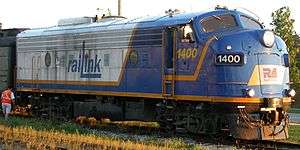Mackenzie Northern Railway
| Reporting mark | RLGN |
|---|---|
| Locale | Alberta, Northwest Territories |
| Dates of operation | 1964–present |
| Track gauge | 4 ft 8 1⁄2 in (1,435 mm) standard gauge |
| Headquarters | Peace River, Alberta |
The Mackenzie Northern Railway (reporting mark RLGN) is a 602-mile (969 km) Canadian railway operating in Alberta and the Northwest Territories.[1] It is the northernmost trackage of the contiguous North American railway network.[2] Since being purchased by CN in 2006, it has been officially known as the Meander Subdivision.[3]
History
The majority of the tracks which the Mackenzie Northern Railway uses were built by the federal government as the Great Slave Lake Railway, running from a point on the Northern Alberta Railways at Grimshaw, Alberta to the southern shores of Great Slave Lake at Hay River, Northwest Territories.[4] The undertaking started in 1961 with a proposal to Parliament, and the line opened in 1964.[5] This railroad was part of Lester B. Pearson's vision for the north,[5] and would facilitate shipment of lead-zinc ore from the Pine Point Mine.[4][5]
The Great Slave Railway's operation was entrusted to Canadian National Railway in 1966, which had been operating the line on behalf of the federal government since it opened. A spur line continued east from Hay River along the south shore of Great Slave Lake to the mine at Pine Point. This section was abandoned in 1988 after the mine closed and ore concentrate shipments ceased.[4] The total mileage in the Northwest Territories from the border with Alberta to Hay River is approximately 80 miles (130 km).
In 1981, CN purchased the other half of the Northern Alberta Railways from Canadian Pacific Railway,[6] allowing CN to operate continuously from Edmonton to Hay River.
Sale to RailLink Canada
Between November 1997 and May 1998 CN sold its lines running from Smith, Alberta, on the former NAR (north of Edmonton) to Peace River and Grimshaw and on to Hay River to a shortline operator, RailLink Canada.[7] RailLink Canada consolidated these lines under the name Mackenzie Northern Railway.

RailLink Canada was subsequently purchased by RailAmerica, which operated the Mackenzie Northern Railway between Smith and Hay River. Commodities includes agriculture and forest products from northeastern Alberta and the southern Northwest Territories, as well as fuel and supplies destined for Arctic communities to be barged across Great Slave Lake and down the Mackenzie River to the Beaufort Sea.[7]
CN buys lines back
On January 19, 2006, CN announced the purchase from RailAmerica Inc. of the Mackenzie Northern Railway, the Lakeland & Waterways Railway, and the Central Western Railway (jointly known as RLGN/CWRL).
CN came full circle by paying $26 million for the three northern Alberta rail lines it sold nine years previously.[8]
References
- ↑ "Promoting Railway Safety In the Community". Railway Association of Canada. 2004-09-07. Archived from the original on 2009-01-15. Retrieved 2009-01-15.
- ↑ "Northern Connections: A Multi-Modal Transportation Blueprint for the North". Government of Yukon. February 2008. p. 12. Archived from the original (PDF) on 2009-01-15. Retrieved 2009-01-15.
- ↑ http://www.nnsl.com/frames/newspapers/2012-07/jul23_12fre.html
- 1 2 3 Wonders, William C. (2003). Canada's Changing North. McGill-Queen's Press. p. 296. ISBN 978-0-7735-2640-2. Retrieved 2009-01-15.
- 1 2 3 Chodos, Robert (1973). The CPR: a Century of Corporate Welfare. James Lorimer & Company. pp. 39–40. ISBN 978-0-88862-047-7. Retrieved 2009-01-15.
- ↑ Murray, Tom (2004). Canadian National Railway: Canada's Transportation Icon, 1919-2004. MBI Publishing Company. p. 107. ISBN 978-0-7603-1764-8. Retrieved 2009-01-18.
- 1 2 "Rail service to Hay River". Northern News Service Online. August 2003. Archived from the original on 2009-01-15. Retrieved 2009-01-15.
- ↑ "CN purchases RailAmerica's Alberta short lines for C$26 million". Business Wire. CN. Archived from the original on 2009-01-18. Retrieved 2009-01-19.
External links
- Popular Mechanics featured an article on the railway: https://books.google.de/books?id=x9MDAAAAMBAJ&pg=PA110